A rewarding day in Glasgow
Can you see the best with just a day in Glasgow? Are there must see places or is it all shopping, eating and drinking? Starting it at the once-trendy Merchant City, we wander eastward via a fascinating Central Station walking tour and encounter the vibrant West End. (Vibrant is unavoidable if describing Glasgow.)
Here’s a day we spent in Glasgow recently. If you are thinking of adding this city to your tour plan, then read on!
“If Edinburgh is a series of panoramas,
then Glasgow is a thousand little details.”
— Some guy who used to write a lot of tourism brochures. (OK, so it was me.)
That is a slightly complicated way of saying that, while you just stand and admire the views in Scotland’s capital, with downtown Glasgow you have to really look to appreciate the architectural heritage and city ambience.
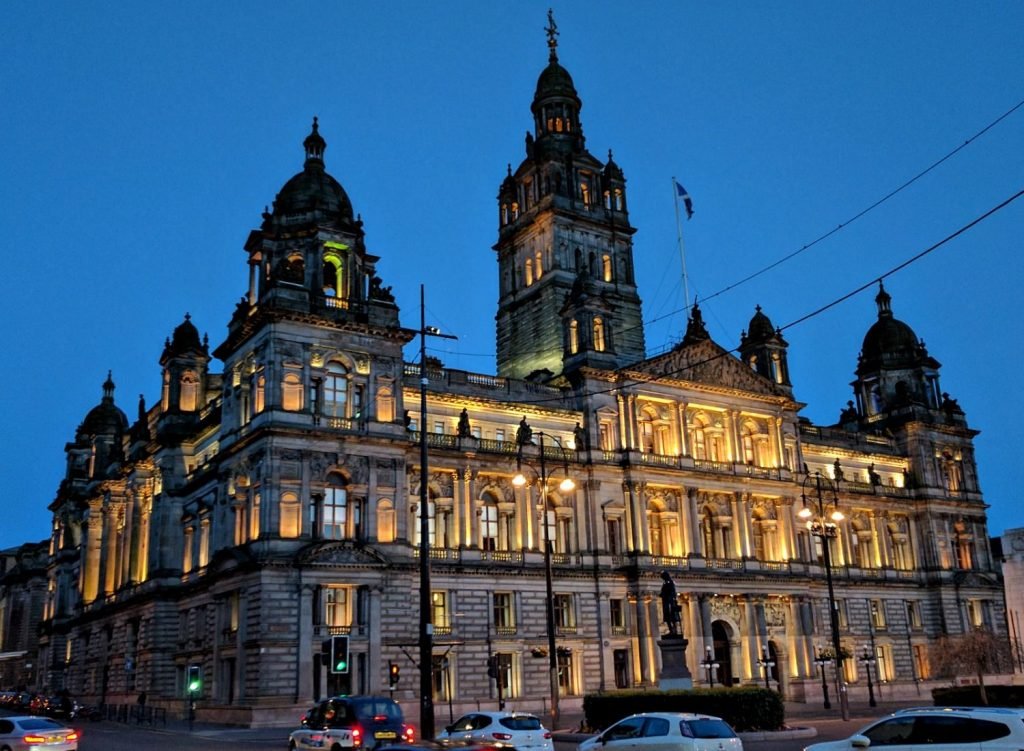
One way of spending your day in Glasgow
So this could be what to see in Glasgow, Scotland, in one day.
A few moments from our idiosyncratic but friendly, budget Z Hotel, we decanted ourselves into George Square – the very heart of the city.
Here’s a quote from an old pre-internet printed architectural guide, where the dominating building on the east side of the square – The City Chambers – is described as ‘a proud expression of the civic dignity, wealth and lavish decoration of 19th-century Glasgow’. Can’t put it better than that.
Looks good at dusk/night too. Plus, there are free tours of the building, twice daily Mon-Fri. You sometimes don’t even need to pre-book.
Anyway, we went kind of south and east, towards the part of the town labelled the Merchant City.

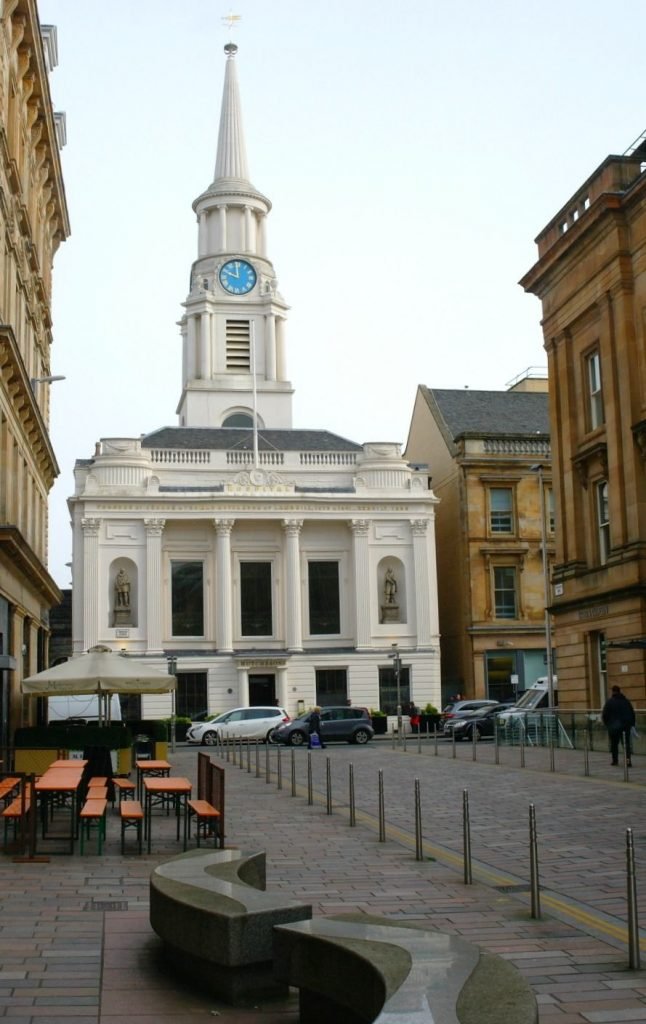
Glasgow’s Merchant City
What and where is this Merchant City that was for so long a pillar of Glasgow’s tourism marketing?
Well, the original merchants were entrepreneurial Glaswegians who made vast fortunes trading in tobacco grown on the other side of the Atlantic.
The trade was at its peak in the 18th century, before the USA declared independence (Lucky old USA).
The Merchant City is a label for the part of Glasgow where the merchants formerly lived and also had their warehouses. It is greatly altered since their day.
Not that long ago, we guidebook writers used to bang on about the mercantile past of Glasgow quite blithely…like it was all deal-making and wholesome trading. Truth is…
The Merchant City – built on slavery
The so-called ‘Tobacco Lords’ were really involved in a dreadful trade, entirely dependent of slavery. Scotland’s participation in this has often in the past been glossed over.
The full story is these days much more widely acknowledged and expertly told in books such as ‘Recovering Scotland’s Slavery Past’ by the peerless Sir Tom Devine.
However, in Glasgow’s defence, by the early 19th century it became a leading light in the Abolitionist movement. (And, obviously, prefers to see itself in that light!)
Anyway, mostly nefariously accumulated, there was money galore sloshing around and some of the buildings that the tobacco cash funded still survive, east of the main shopping area today.
Discover distinctive 18th-century architecture on a day in Glasgow
There’s Hutchesons’ Hall (1802-5) with clock and steeple, closing the view up Hutcheson Street; and the Trades House (Robert Adam 1791-4) performing the same function on Garth Street, beyond the giant blue wheelie bins and beer kegs that are a reminder that this is an eating and drinking hotspot.
And there’s much more architecture to admire: clever conversions – warehouses into flats, for example – or markets into exhibition spaces – and part of an old fruit-market has been re-labelled Merchant Square.
An explanatory notice outside says ‘Merchant Square – where it never rains’ – a reminder of just one of the advantages of having a roof. Basically, it’s a big hall with – guess what? – even more restaurants.
How do they all survive these days?
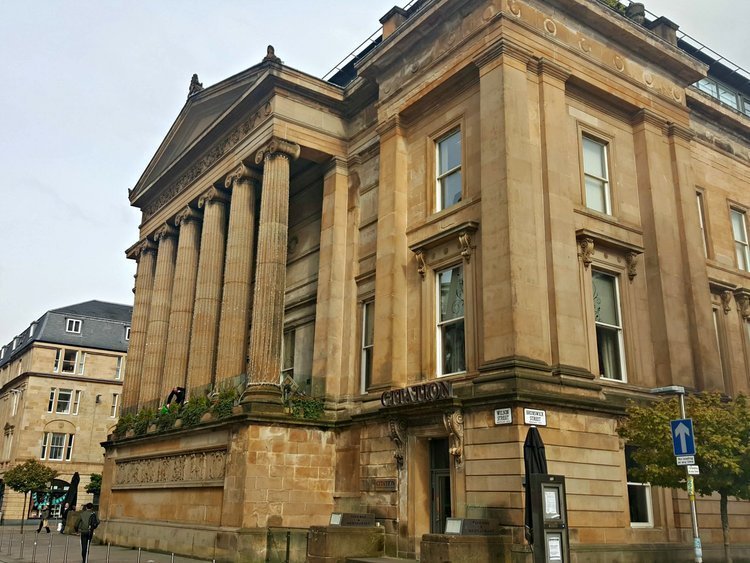
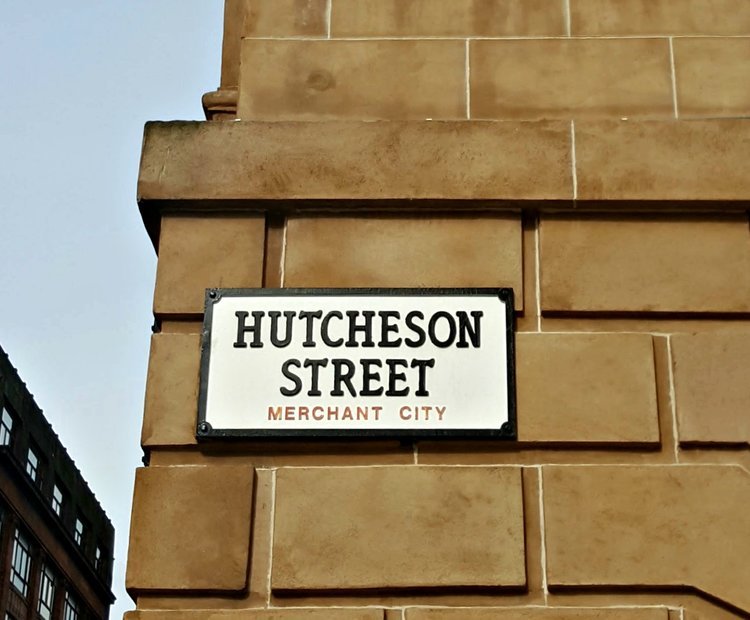
Yes, there are lots of fine buildings: St Andrew’s in the Square is an 18th-century A-listed former church, still considered one of the finest classical churches in the British Isles.
It’s now much cheerier than your average Scottish kirk though, as it’s now Glasgow’s Centre for Scottish Culture, promoting Scottish music, song and dance. They often hold ceilidhs here …
City of Contrasts
We strolled eastwards towards the oldest part of the city. Glasgow expanded west from the environs of the Cathedral via the mansions and warehouses of the Tobacco Lords of the Merchant City.
Next, we dropped down and past the Tolbooth to the Trongate (the continuation eastward of Argyle Street), where we were reminded of this city of contrasts.
It isn’t stylish and trendy there. Just run down, with greenery growing out of the boarded up facades.
And it’s five minutes from a jewellery arcade and the bustling Buchanan Street with its upmarket shops. Funny old place, this city.

Glasgow – shop, eat, drink, shop some more
Let’s be blunt here. The middle of Glasgow – I mean the walkable part you reach, say, from Queen Street or Central Station – is mostly about shopping. And eating and drinking. And you can easily spend your day in Glasgow doing that and nothing more!
There are few cultural Glasgow-must-sees right in the heart, with notable exceptions such as The Tenement House, though there are some ‘might-as-well-take a-look-since-we’re-here’ places.
This certainly includes GOMA, Glasgow’s Gallery of Modern Art, housed in what was, in its original form, the home of a prosperous tobacco merchant. (Well, it would be, wouldn’t it?)

More handsome Glasgow Architecture – look up !
So the city on first impressions divides into the prosperous shopping streets in the L shape of Buchanan Street and Sauchiehall Street, with the Merchant City just to the east.
And it strikes me that the Merchant City just doesn’t have the footfall to sustain the designery kind of shops that once enhanced it, say, back in the 1980s – so it’s mostly all nightlife and eating and drinking these days. (Just a general impression, from your country boy.)
However, the joy of wandering about the ‘shopping streets’ is that, yes, there are indeed a thousand architectural details to note above the shop windows, especially if you look up.
Eyes skywards to enjoy the Ca D’Oro building (John Honeyman 1872) and, further along the street by Central Station, the Grosvenor Building (Alexander Thomson 1862), the Hatrack (James Salmon 1899)…and so on and on and on until your neck gets a bit sore.
But wait, there’s a whole lot more than just the city-centre architecture. Keep reading…
Glasgow’s West End
Glasgow’s West End is another facet of the city and it can be included in a day excursion of the city. Go by the subway (as we did) or by taxi.
Emerge, minutes later, from Hillhead station on to, say, Byres Road and, as well as the shops and the cafes, quite easily reached from this busy street, there are quite a few cultural opportunities.
Scotland’s oldest museum, the Hunterian, located within the university precincts, is worth a look; as is the Hunterian Art Gallery. For instance, Whistler is well represented here, and also the Glasgow Colourists with their beautiful renderings of the light on the island of Iona.
Then there are the beautiful interiors of the Mackintosh House – they’re all here in a compact area.
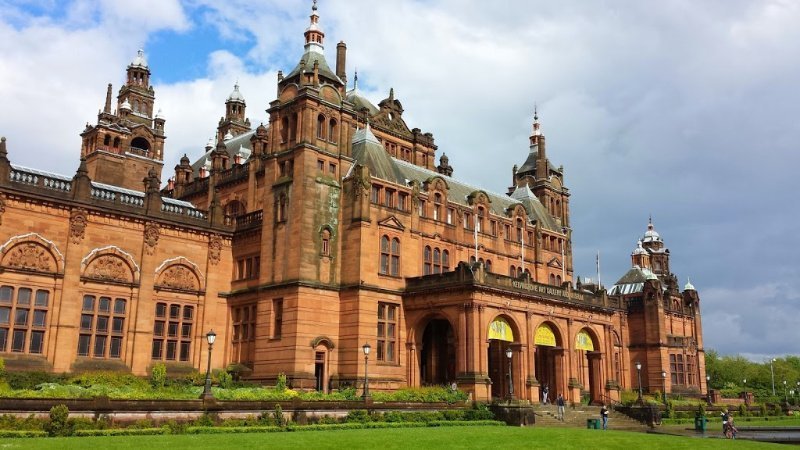

Glasgow’s Fine Civic Art Collections
And, as we were so close, we went to pay our respects to the Kelvingrove Art Gallery and Museum.
For generations it’s been up there amongst Scotland’s most popular free attractions – and with good reason, as it’s everything a ‘traditional’ ‘proper’ museum and gallery could be.
We even managed to time it for 1pm and the (free) organ recital. And we got a seat in the cafe too! Kelvingrove features some of the finest civic collections anywhere in the British Isles.
It’s the place to see the work of the painters known as The Glasgow Boys. It’s easy to get back to, say, Buchanan Street by subway, from Kelvinhall station.
Central Station Walking Tour
Right, time to get back to the city-centre. Our day was wearing on and we had a very important appointment.
We all met below the ‘longitudinal ridge and furrow’ glass roof on the concourse of Central Station. We were going on a behind the scenes tour of Glasgow Central Station.
Kitted out in high-viz jackets and hats, we joined our tour, led by the originator, champion, and promoter of the event, Paul Lyons.

“It was, quite simply, the best guided tour we have ever done – period. Vivid, funny, dark and dramatic in turn.”

Central Station covers an area about two square miles and much of it is below ground.
The tour took us back to the booming, bustling, noisy, filthy days of Victorian Glasgow, to arched walkways and old platforms, below hand-riveted girders well over a century old that are as good as they day they were installed.
Go back in time
Paul also took us back to the early days of the First World War and the pathetic human cargoes of warfare that were dropped off on the platform for the womenfolk to view, identify (can you believe) and take away. Mostly, it was what was left of their menfolk.
Before the policy changed and fatalities were buried in France, the British Army’s responsibility for them apparently ended when the left them on the platform, a temporary morgue.
It was, quite simply, the best guided tour we have ever done – period. Vivid, funny, dark and dramatic in turn, it left us with fresh insight into the life, past and present, of this grand station. NB You must book this tour in advance.
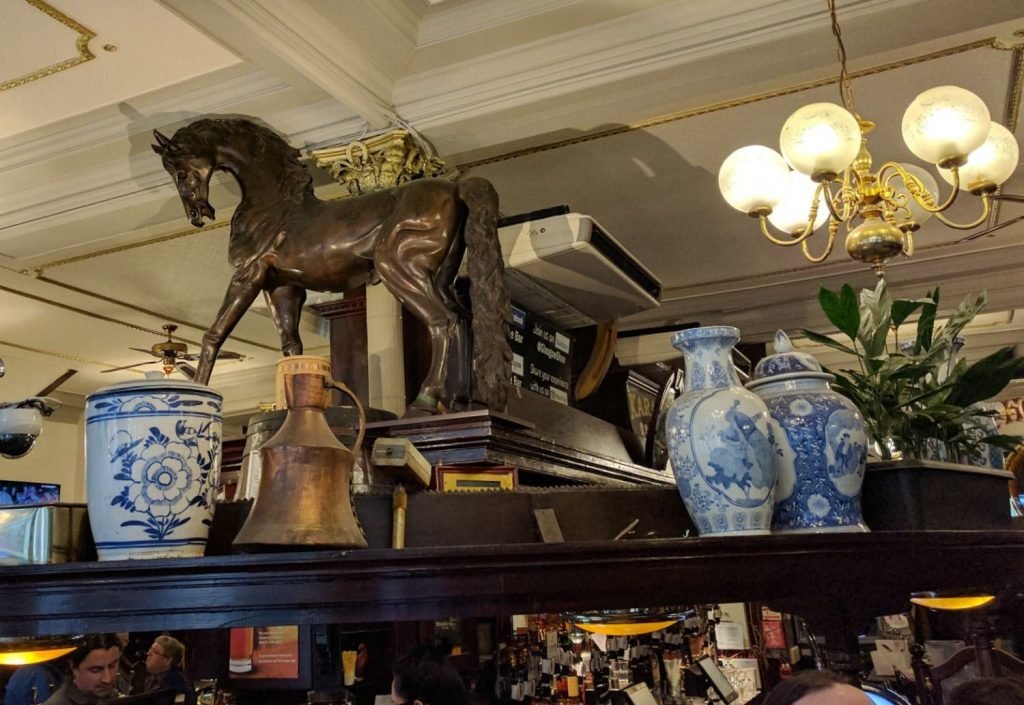
The Pubs of Glasgow
We were so reduced to silence and reflection by the Glasgow Central Station tour experience that we thought it would be good to mull it over in a proper pub.
(Any excuse, really.) Glasgow has, uhmm, quite a few.
We went to The Horseshoe Bar, because it’s the real deal, not hugely changed since 1888, apart from the introduction of salt and vinegar crisps, which we don’t think were around then.
However, the grand Victorian bar is 104 ft 3 inches (32m) which makes it the longest in Europe, they say. Fortunately it’s in an oval – before I visited I always imagined it as a long thin counter. Stupid boy. Wrong.
In summary – our day in Glasgow
To recap, we had: a stroll in the Merchant City, a wander back up Buchanan Street, morning coffee at the most excellent Riverhill Coffee Bar in Gordon Street, caught the subway to the West End, walked via Ashton Lane to Kelvingrove Art Gallery & Museum.
Then we heard an organ recital, enjoyed the Glasgow Boys paintings, caught the subway back again back from Kelvinhall to the city centre, poked about in some more shops then had a tour of Central Station. Went for a drink, went back to the hotel for the wine and cheese…
It was a very nice day. Sad to see so many people begging, especially the ones with dogs, but it’s only slightly worse than, say, Edinburgh.
When Scotland becomes independent – and the city of Glasgow certainly voted that way – then perhaps we can put in place a more socially responsible and caring way of government and find a way of tackling the issue.
But anyway, contrasts between rich and poor have always been a feature of Glasgow, though not necessarily its best one.
Check the football fixtures before you plan your day in Scotland’s largest city. Why? Find out more on our page: a quiet Sunday afternoon in Glasgow.